DocuSign Workflow Sample - Single Signer
The following procedure details a sample workflow and forms for a sequence that contains single signer.
Prerequisites
-
The DocuSign properties are configured in Forms Builder. See DocuSign Settings.
-
A form sequence with the necessary DocuSign components for a single signer is created. In our example, the Anonymous property of the sequence is set to false.
Note: If you create a non-authenticated sequence (Anonymous=true), make sure that the user's email address is included in the sequence. The email address is required as the DocuSign recipient address.
-
A form that contains an IFrame component is created. In our example, this form is named Default-Frame with the following properties (case sensitive):
- Name = docuSignFrame
- Url = {{vm.models.frameUrl}}
The IFrame form can be part of the initial sequence; however, in the procedure below, we are adding the form to the workflow.

We recommend that you copy the original Default-Frame form, edit the copy, and use it in your sequences. Save a backup copy of your form.
To optimize the display of your e-signature forms on mobile devices, you may want to add the CSS described in this Note.
Enhancements in Forms Builder 3.6
The DocuSign component provides additional values on the Type property: Approve, Attachment, Checkbox, Company, Date, Decline, Email, Email Address, Envelope Id, Number, Ssn, and Text.
The DocuSign component provides an automatic transition (auto-redirect) from the Default-Frame form to the confirmation form after a successful DocuSign session. The auto-redirect obsoletes the "DocuSign Confirmation Message Text" setting.
The auto-redirect depends on a forward direction in the WaitForFormBookmark activity in the transition after the DocuSign redirect state (typically Default-Frame), in particular if DisplayName has been modified.
-
If there is only a single button and DisplayName has been customized but Transition Type was left as "Default", the auto-redirect moves forward to next form state.
-
If there are two buttons and DisplayName(s) have been customized but Transition Type was left as "Default", the auto-redirect will assume the rightmost button (alphabetically last) is the transition for next state.
Best Practice is always to specify Display Order and Transition Type (“MoveForward” or “MoveBack”) when button Display Name(s) have been customized so behavior is known. The Transition Type of “Default” was kept for compatibility for forms built prior to Transition Type being available on WaitForFormBookmark with default Display Names "Next" and "Back”.
Create the Workflow
-
Launch Workflow Composer and open the workflow. See Open the Workflow for a Sequence.
-
In Workflow Composer, drag the State icons and Transition lines to so that you can easily locate each item in the StateMachine workflow.
The workflow requires the following arguments and variables. You can create these arguments and variables before working on the activities, or you can add them when they are needed for a specific activity (as described below).
|
|
Keep in mind that arguments are passed in JSON format and that JSON elements are case sensitive. Be sure to match the casing of argument names in Workflow Composer and Form Designer. |

|
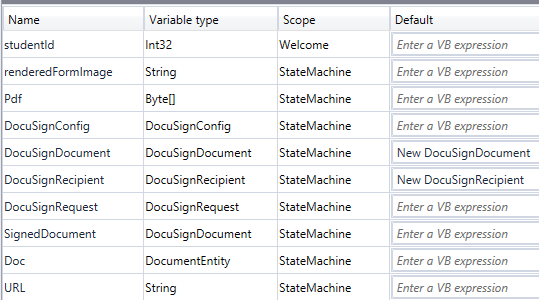
|
LogLine Activities
While testing and troubleshooting the workflow, we recommend adding LogLine activities at critical stages within the workflow. The following expression will provide logging for specific objects (replace <object> with the object name):
Newtonsoft.Json.JsonConvert.SerializeObject(<object>, Newtonsoft.Json.Formatting.Indented)
For example, to capture errors related to the CreateDocuSignRequest activity, you would place a LogLine activity with the following expression below the CreateDocuSignRequest activity.
Newtonsoft.Json.JsonConvert.SerializeObject(DocuSignRequest, Newtonsoft.Json.Formatting.Indented)
We recommend setting the Level value to Information for any LogLine or LogObject activities. See Best Practices for Logging and Logging in Azure.
Note: If your sequence is non-authenticated (Anonymous=true), the LookupUser and GetEntity activities are not applicable, but a CreateEntity activity may be needed instead. Be sure that any anonymous sequence includes the user's email address. It is required as the DocuSign recipient address.
The first step is to capture the information of the user who logged in to the form.
- Create a variable named studentId of Type Int32.
-
Drop a LookupUser activity in the Entry area of the Welcome form.
- In the UserId property, specify studentId. This is the variable created in the previous step.
- In the UserName property, specify formInstance.UserName. The user name is retrieved from the login account information.

-
Drop a GetEntity activity in the below the LookupUser activity.
- In the EntityId property, specify studentId.
- In the Result property, specify studentEntity.
Workflow Composer automatically wraps the activities in a Sequence.
-
Save the workflow locally and continue with the next set of steps.
Since the workflow can be busy for a long time, we recommend that you persist the workflow instance before creating the PDF.
-
Double-click the Next transition from the form that is used to collect the data, CMC_Student_Personal Info.
-
Drag a Persist activity into the Trigger area below the Next activity. The Persist activity does not require any properties to be specified.
Workflow Composer automatically wraps the Next and Persist activities in a Sequence.
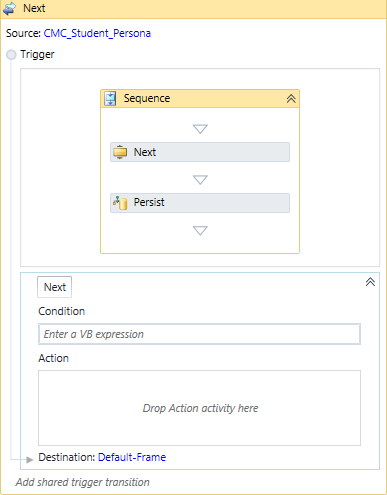
-
Save the workflow locally and continue with the next set of steps.
-
In Workflow Composer, click the Arguments tab.
-
Create an argument named frameUrl. Set the Direction to In/Out. Set the Type to String.

Be sure to use the exact casing shown here. -
Click the StateMachine link in the Designer pane.
-
Drop a State activity onto the transition line after the Next transition from the form that contains the DocuSign components (CMC_Student_Personal Info).

-
Change the default name of the State activity to the name of the form that contains the IFrame. In our case, the name is Default-Frame.
-
Save the workflow locally and continue with the next set of steps.
In the following steps we will create a set of activities in the Default-Frame State, which represents the IFrame form.
-
Double-click the State icon of the form that contains the IFrame component.
-
Create a variable named URL. Set the Variable type to String. Set the Scope to StateMachine. This variable will be assigned to the PDF that will be created from the form.
Note: As of Forms Builder 3.5, the URL input argument for the PrintUrlToPdf activity is optional. When the URL is not specified, the activity constructs the URL for all forms traversed in the sequence.
-
Drop an Assign activity into the Entry area of the State.
-
In the To field, specify the variable name URL.
-
In the Value field, specify the following:
formInstance.RendererBaseUrl + "#/viewCreator/" + formInstance.WorkflowDefinitionId.ToString + "/forms=CMC_Student_Personal+Info"
Where "/forms=CMC_Student_Personal+Info" indicates the Forms Builder form that contains the DocuSign component.
Notes
-
If the form name has a space, replace the space with a + sign as shown in the example: CMC_Student_Personal+Info
-
If multiple forms are sent to DocuSign, specify a comma-separated list of form names in the "/forms=" attribute.
-
-
-
Drop a Persist activity below the Assign activity.
-
Create a variable with a name like Pdf. Set the Scope to StateMachine. This variable will hold the document image created from the form.
Note: Make sure you use the same variable name when you reference this variable later in the workflow. (This applies to any other variable.)
-
In the Variable type field, select Array of [T] and select Browse for Type.
-
In the "Browse and Select a .Net Type" window, specify "byte", select the System variable "Byte", and click OK.

-
-
Drop a PrintUrlToPdf activity below the Persist activity.
Specify the properties for the activity as follows:
-
PdfDocument = Pdf (This is the name of the variable created above.)
-
Url = URL (This is the name of the variable created above.)
Note: As of Forms Builder 3.5, the URL input argument for the PrintUrlToPdf activity is optional. When the URL is not specified, the activity constructs the URL for all forms traversed in the sequence.
-
Validation Messages = formInstance.ValidationMessages
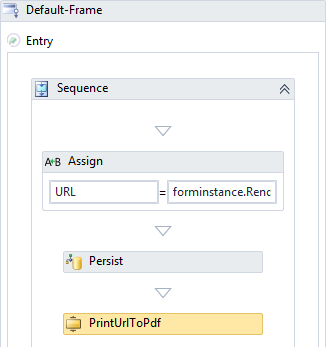
-
-
Save the workflow locally and continue with the next set of steps.
In the following steps we will continue to add activities to the Default-Frame State, which represents the IFrame form.
-
Create a variable named DocuSignConfig. Set the Scope to StateMachine.
In the Variable type field, select Browse for Type. In the "Browse and Select a .Net Type" window, scroll down to Cmc.Nexus.FormsBuilder.Contracts > Cmc.Nexus.FormsBuilder.Entities and select DocuSignConfig.
-
In the State of the IFrame form, drop a GetDocuSignConfig activity below the PrintUrlToPdf activity.
Specify the properties for the activity as follows:
- DocuSignConfig = DocuSignConfig
- Validation Messages = formInstance.ValidationMessages
The GetDocuSignConfig activity retrieves the User Name, Password, Integrators Key, and REST API Url from the DocuSign settings in Forms Builder. These values enable the workflow to log in to DocuSign.
Note: If the REST API Url (see DocuSign Settings) was configured as the Demo Url instead, the sequence could be tested without reassigning BaseUrl later. If DocuSignConfig.TestMode=true, this Demo URL will be used (hard-coded in the code). The assign step for the BaseUrl really should be changed to assign TestMode instead of reassigning the BaseUrl. When the TestMode assignment is deleted, the workflow it is ready for production. If you have the BasePath configured for the production URL for DocuSign, the setting TestMode=true will substitute the hard-coded demo URL https://demo.docusign.net/restapi for the BaseUrl.
As of Forms Builder 3.4, the DocuSignConfig.TestMode assignment (=true or =false) is no longer supported or functional. Assign statements containing it can be deleted.
To process the DocuSign request, the Email Subject and Return URL properties need to be assigned to the DocuSignConfig variable. These properties are required.

The only two properties for the DocuSignConfig object that should ever be modified in the workflow definition are EmailSubject and ReturnUrl. The values for all the other properties are retrieved from the DocuSign Settings saved in the database. Any modification done to the values for the other DocuSignConfig properties in the workflow definition will likely result in errors when the DocuSign portion of the sequence is executed. -
Create the following variables:
Variable Name Type Scope Default DocuSignRecipient Cmc.Nexus.FormsBuilder.Entities.DocuSignRecipient StateMachine New DocuSignRecipient DocuSignDocument Cmc.Nexus.FormsBuilder.Entities.DocuSignDocument StateMachine New DocuSignDocument DocuSignRequest Cmc.Nexus.FormsBuilder.Entities.DocuSignRequest StateMachine N/A -
Below the GetDocuSignConfig activity, drop an Assign activity for each row in the following table and type the indicated values:
"To" Field Value Notes DocuSignConfig.EmailSubject "CMC Campus DocuSign Testing" This is the email that the end user will receive after the signing process is done. DocuSignConfig.ReturnUrl formInstance.RendererBase
Url+"#/docusigncomplete"This is the URL that will display the document after the signing process is done. DocuSignDocument.DocumentId "1" When multiple DocuSign documents are included in the same DocuSign envelope, every document needs a unique Id. In this example, there is only one document. DocuSignDocument.Name "StudentInfoPdf.pdf" Name of the signed document. DocuSignDocument.Content Pdf Name of the variable that holds the document image (see Create a PDF of the Form). In our example the name of the variable is Pdf. DocuSignRecipient.FirstName studentEntity.FirstName First name of the user who submitted the signed document. DocuSignRecipient.LastName studentEntity.LastName Last name of the user who submitted the signed document. DocuSignRecipient.Email "tester@anthology.com" Email address of the person who will receive the signed DocuSign document. DocuSignRecipient.ConcealSSN True By default, the value is set to True, which masks the Ssn field value typed by the recipient. Set the value to False to display the typed value. DocuSignRecipient.SignerId "1" The SignerId should match the Signer property in the DocuSign component on the form. Allowed values are "1" to "5". "To" Field Value Notes DocuSignConfig.EmailSubject "CMC Campus DocuSign Testing" This is the email that the end user will receive after the signing process is done. DocuSignConfig.ReturnUrl formInstance.RendererBase
Url+"#/docusigncomplete"This is the URL that will display the document after the signing process is done. DocuSignDocument.DocumentId "1" When multiple DocuSign documents are included in the same DocuSign envelope, every document needs a unique Id. In this example, there is only one document. DocuSignDocument.Name "StudentInfoPdf.pdf" Name of the signed document. DocuSignDocument.Content Pdf Name of the variable that holds the document image (see Create a PDF of the Form). In our example the name of the variable is Pdf. DocuSignRecipient.FirstName studentEntity.FirstName First name of the user who submitted the signed document. DocuSignRecipient.LastName studentEntity.LastName Last name of the user who submitted the signed document. DocuSignRecipient.Email "tester@anthology.com" Email address of the person who will receive the signed DocuSign document. DocuSignRecipient.SignerId "1" The SignerId should match the Signer property in the DocuSign component on the form. Allowed values are "1" to "5". -
Save the workflow locally and continue with the next set of steps.
In the following steps we will continue to add activities to the Default-Frame State, which represents the IFrame form.
-
Drop the CreateDocuSignRequest activity below the previous activity.
Specify the properties for the CreateDocuSignRequest activity using the names of the variables created above as follows:

Warning: Do not enter anything in ResumeBookmark if you are creating Single Signer workflows. This could cause InstanceHandleConflictExceptions and aborted workflows. Fill this in only for Multi-Signer workflows.
The out argument DocuSignRequest returns the envelope Id and URL of the signed DocuSign document.
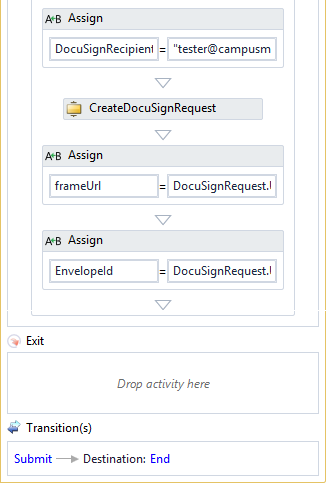
-
Drop an Assign activity below the CreateDocuSignRequest activity.
-
In the To field, specify frameUrl. (This is the argument associated with the IFrame form.)
 Be sure to use the exact casing shown here.
Be sure to use the exact casing shown here. -
In the Value field, specify DocuSignRequest.Url.
-
-
Drop another Assign activity into the workflow.
-
In the To field, specify EnvelopId.
-
In the Value field, specify DocuSignRequest.EnvelopeId.
Notes
-
This assignment allows for the reuse of the EnvelopeId. If EnvelopeId has a value, it will be reused; if not a new one is generated (and can be assigned to a variable for reuse).
-
This assignment is needed only for the primary/single signer (logged in Student) use cases. Signatures for multiple signers will be done outside of the workflow within DocuSign.
-
-
Save the workflow locally and continue with the next set of steps.
In the following steps we will create activities in the Submit transition which follows the IFrame form.
-
Double-click the T1 transition after the Default-Frame state and rename it as Submit.
-
Drop a WaitForFormBookmark activity into the Trigger area of the Submit transition.
-
Rename the WaitForFormBookmark activity as Submit.
-
Create a variable named SignedDocument. In the Variable type field, select DocuSignDocument. Set the Scope to StateMachine.
-
Create another variable named SignedDocumentList. In the Variable type field, select List Collection (system.collection.Generic.List<T>) and inside the List, select the DocuSignDocument Entity (Cmc.Nexus.FormsBuilder.Entities.DocusignDocument). Set the Scope to StateMachine.
-
Drop a GetSignedDocument activity below the Submit activity.
Specify the properties for the activity as follows:
-
DocusignConfig = DocusignConfig (This is the variable created for the DocusignConfig Entity)
- DocuSignDocument = SignedDocument (This is the name of the variable created above.)
-
DocusignDocumentList = SignedDocumentList (This is the name of the variable created above.)
- EnvelopeId = DocuSignRequest.EnvelopeId
-
ReturnList = True
- Validation Messages = formInstance.ValidationMessages
Workflow Composer automatically wraps the activities in a Sequence.

-
-
Save the workflow locally and continue with the next set of steps.
Note: If it is necessary to troubleshoot the receipt of the signed document, you might want to consider the procedure of Write the PDF to Disk.
In the following steps we will create activities in the Submit transition which follows the IFrame form.
-
Double-click the T1 transition after the Default-Frame state and rename it as Submit.
-
Drop a WaitForFormBookmark activity into the Trigger area of the Submit transition.
-
Rename the WaitForFormBookmark activity as Submit.
-
Create a variable named SignedDocument. In the Variable type field, select DocuSignDocument. Set the Scope to StateMachine.
-
Create another variable named SignedDocumentList. In the Variable type field, select List Collection (system.collection.Generic.List<T>) and inside the List, select the DocuSignDocument Entity (Cmc.Nexus.FormsBuilder.Entities.DocusignDocument). Set the Scope to StateMachine.
-
Drop a GetSignedDocument activity below the Submit activity.
Specify the properties for the activity as follows:
-
DocusignConfig = DocusignConfig (This is the variable created for the DocusignConfig Entity)
- DocuSignDocument = SignedDocument (This is the name of the variable created above.)
-
DocusignDocumentList = SignedDocumentList (This is the name of the variable created above.)
- EnvelopeId = DocuSignRequest.EnvelopeId
-
ReturnList = True
- Validation Messages = formInstance.ValidationMessages
Workflow Composer automatically wraps the activities in a Sequence.

-
-
Save the workflow locally and continue with the next set of steps.
Note: If it is necessary to troubleshoot the receipt of the signed document, you might want to consider the procedure of Write the PDF to Disk.
In the following steps we will create activities in the Submit transition which follows the IFrame form.
-
Double-click the T1 transition after the Default-Frame state and rename it as Submit.
-
Drop a WaitForFormBookmark activity into the Trigger area of the Submit transition.
-
Rename the WaitForFormBookmark activity as Submit.
-
Create a variable named SignedDocument. In the Variable type field, select DocuSignDocument. Set the Scope to StateMachine.
-
Drop a GetSignedDocument activity below the Submit activity.
Specify the properties for the activity as follows:
- DocuSignDocument = SignedDocument (This is the name of the variable created above.)
- EnvelopeId = DocuSignRequest.EnvelopeId
- Validation Messages = formInstance.ValidationMessages
Workflow Composer automatically wraps the activities in a Sequence.
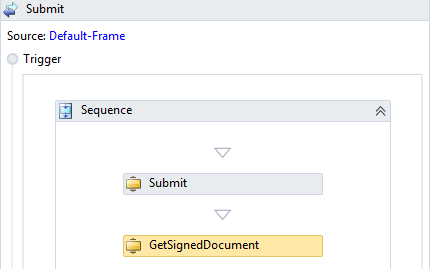
-
Save the workflow locally and continue with the next set of steps.
Note: If it is necessary to troubleshoot the receipt of the signed document, you might want to consider the procedure of Write the PDF to Disk.
Content in this section is not available in version 4.0.
In the following steps we will create activities in the Submit transition which follows the IFrame form to fetch the data submitted by the signer and add the data in the renderer log.
-
Create a variable named TagName. In the Variable type field, select String. Set the Scope to StateMachine.
-
Create a variable named Value. In the Variable type field, select String. Set the Scope to StateMachine.
-
Create a variable named DocuSignRecipients. In the Variable type field, select Array of <T> and from the T dropdown, select Cmc.Nexus.FormsBuilder.Entities.DocuSignRecipient. Set the Scope to StateMachine.
-
Create a variable named DocuSignFormData. In the Variable type field, select the List Collection (system.collection.Generic.List<T>) and inside the List select the DocuSignFormDataitem Entity(Cmc.Nexus.FormsBuilder.Entities.DocuSignFormDataitem.). Set the Scope to StateMachine.
-
Drop a GetDocuSignRecipientFormData activity below GetSignedDocument activity.
Specify properties for the activity as follows:
-
DocuSignConfig = DocuSignConfig (This is the variable created for DocusignConfig Entity)
-
DocuSignRecipients = DocuSignRecipients (This is the variable created above)
-
EnvelopeId = DocusignRequest.EnvelopeId
-
ValidationMessage = forminstance.ValidationMessages

-
-
Drop a ForEach<> activity below the GetDocuSignRecipientFormData activity. Specify the TypeArgument as Cmc.Nexus.FormsBuilder.Entities.DocuSignRecipient And Values as ‘DocuSignRecipients’ (This is the name of the variable created above).
-
Drop an Assign activity inside the ForEach<> activity, and specify the following values:
-
To = DocuSignFormData
-
Value = item.FormData
-
-
Drop a ForEach<> activity below the Assign activity.
Specify the TypeArgument as Cmc.Nexus.FormsBuilder.Entities.DocuSignFormDataItem.
Specify the Value as in ‘DocuSignFormData (This is the name of the variable created above)
-
Drop an Assign activity inside the ForEach<> activity, and specify the following values
-
To = TagName
-
Value = item.TagName
-
-
Drop an Assign activity inside the ForEach<> activity, and specify the following values:
-
To = Value
-
Value = item.Value
-
-
Drop a Logline activity and specify the following values:
-
Text = "Formdata Tagnames and Values are :"& Tagname & Value
-
Level = Information

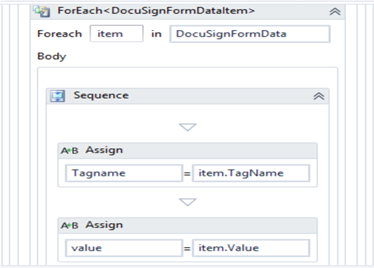
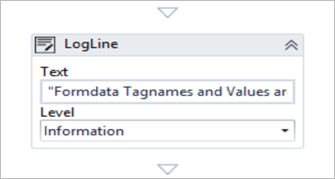
-
To convert a DocuSign document to a DocumentEntity that can be attached to a record in Anthology Student, add the CreateDocument and SaveDocument activities to the workflow. To attach multiple documents/attachments in Anthology Student, add the CreateDocument and SaveDocument activity in a ForEach<> loop. These activities will be placed in the Submit transition.
-
Create a variable named Doc. Set the Scope to StateMachine.
In the Variable type field, select Browse for Type. In the "Browse and Select a .Net Type" window, scroll down to Cmc.Nexus.Crm.Contracts > Cmc.Nexus.Crm.Entities and select DocumentEntity.
-
Drop a ForEach<> activity below the ForEach<> activity dropped below the GetDocuSignRecipientFormData activity.
Specify the Foreach <item> in ‘SignedDocumentList’ (This is the name of the variable created above).
-
Drop an If condition activity inside the Foreach<> Activity. Specify the condition as “item.Name = "Student Info"”.
Note: Student Info is the name of the signed pdf document in the assign activity that was specified by the user in Get the DocuSign Configuration and Pass the Recipient Information.
The If condition ensures that the signed pdf document is saved in the Document Center in Anthology Student and all attachments attached by the signer along with the signed summary report are also saved to the Document Center in Anthology Student. -
Drop a CreateDocument activity and specify the following under the Then condition:
Specify the required properties for the activity as follows:
- Module = Select a Module from the drop-down list.
- Document Type = Select a Type (Template) from the drop-down list.
- Document Status = Select a Type from the drop-down list.
- Student = Specify a Student Id or use a variable.
- Due Date = Specify a date or use a variable, e.g., DateTime.Now
- Document (OutArgument) = Doc (This is the variable created above for the DocumentEntity.)
- Validation Messages = formInstance.ValidationMessages
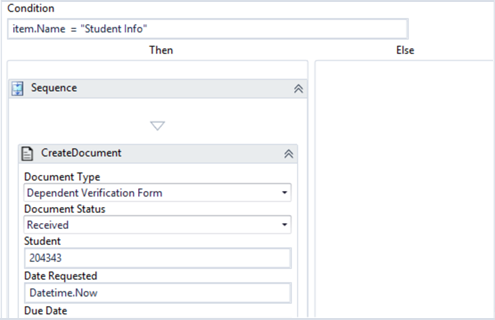
-
Below the CreateDocument activity, drop an Assign activity for each row in the following table and type the indicated values:
"To" Field Value Doc.DocumentImage SignedDocument.Content Doc.OriginalFileName "Signedpdf.Pdf" Doc.ImageType "Pdf" Doc.IsDocumentAddedManually true -
Drop a SaveDocument activity below the CreateDocument activity.
Specify the properties for the SaveDocument activity as follows:
- Document (InOutArgument) = Doc (This is the variable created above for the DocumentEntity.)
- Validation Messages = formInstance.ValidationMessages
-
In the Condition field of the Submit transition, specify the following (to prevent users from submitting a form that has validation errors): Not formInstance.ValidationMessages.Has Errors

-
Save the workflow locally and continue with the next set of steps.
-
Drop a CreateDocument activity and specify the following under the Else condition:
Specify the required properties for the activity as follows:
- Module = Select a Module from the drop-down list.
- Document Type = Select a Type (Template) from the drop-down list.
- Document Status = Select a Type from the drop-down list.
- Student = Specify a Student Id or use a variable.
- Due Date = Specify a date or use a variable, e.g., DateTime.Now
- Document (OutArgument) = Doc (This is the variable created above for the DocumentEntity.)
- Validation Messages = formInstance.ValidationMessages
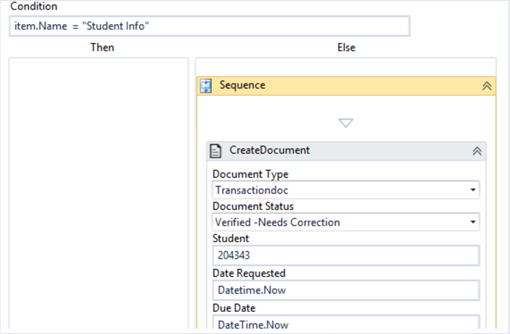
-
Below the CreateDocument activity, drop an Assign activity for each row in the following table and type the indicated values:
"To" Field Value Doc.DocumentImage SignedDocument.Content Doc.OriginalFileName "Signedpdf.Pdf" Doc.ImageType "Pdf" Doc.IsDocumentAddedManually true -
Drop a SaveDocument activity below the CreateDocument activity.
Specify the properties for the SaveDocument activity as follows:
- Document (InOutArgument) = Doc (This is the variable created above for the DocumentEntity.)
- Validation Messages = formInstance.ValidationMessages
-
In the Condition field of the Submit transition, specify the following (to prevent users from submitting a form that has validation errors): Not formInstance.ValidationMessages.Has Errors

- Save the workflow locally and continue with the next set of steps.
To convert a DocuSign document to a DocumentEntity that can be attached to a record in Anthology Student, add CreateDocument and SaveDocument activities to the workflow. These activities will be placed in the Submit transition.
-
Create a variable named Doc. Set the Scope to StateMachine.
In the Variable type field, select Browse for Type. In the "Browse and Select a .Net Type" window, scroll down to Cmc.Nexus.Crm.Contracts > Cmc.Nexus.Crm.Entities and select DocumentEntity.
-
Drop a CreateDocument activity below the GetSignedDocument activity.
Specify the required properties for the activity as follows:
- Module = Select a Module from the drop-down list.
- Document Type = Select a Type (Template) from the drop-down list.
- Document Status = Select a Type from the drop-down list.
- Student = Specify a Student Id or use a variable.
- Due Date = Specify a date or use a variable, e.g., DateTime.Now
- Document (OutArgument) = Doc (This is the variable created above for the DocumentEntity.)
- Validation Messages = formInstance.ValidationMessages
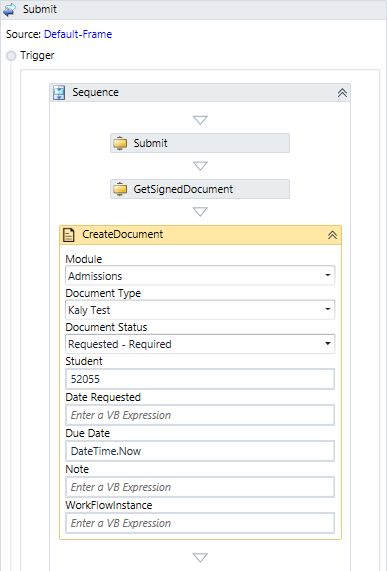
-
Below the CreateDocument activity, drop an Assign activity for each row in the following table and type the indicated values:
"To" Field Value Doc.DocumentImage SignedDocument.Content Doc.OriginalFileName "Signedpdf.Pdf" Doc.ImageType "Pdf" Doc.IsDocumentAddedManually true -
Drop a SaveDocument activity below the CreateDocument activity.
Specify the properties for the SaveDocument activity as follows:
- Document (InOutArgument) = Doc (This is the variable created above for the DocumentEntity.)
- Validation Messages = formInstance.ValidationMessages
-
In the Condition field of the Submit transition, specify the following (to prevent users from submitting a form that has validation errors): Not formInstance.ValidationMessages.Has Errors

-
Save the workflow locally and continue with the next set of steps.
-
Click Publish. The New Workflow Definition Version window is displayed.
-
If you want the workflow to be run as soon as the event occurs on the entity, select Enable This Workflow Version?, otherwise leave the check box cleared.
-
Click Save, then Cancel to close the publisher window.
-
In the Sequence List, select and complete the form that contains the DocuSign fields.
-
Verify that the signed DocuSign document is available at the return URL.
-
Verify that the signed document is added to the Anthology Student database.
Note: While testing your workflow, make sure that you terminate the previous instance of the workflow before running an updated version of the same workflow. In Workflow Composer, click Open Persisted Workflow, select your workflow instance, and click Terminate.
In Forms Builder 3.6 and later, persisted workflow instances can be deleted from the Sequence Designer workspace. For more information, see Delete Persisted Workflow Instances.